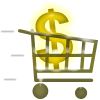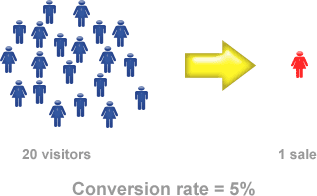 If you’ve just set up your online store, you’re probably tempted to rush out and submit it to the search engines, set up link exchanges and, maybe, pay for some online advertising such as Google AdWords. However, while traffic is certainly important for your online sales, it won’t help much if your conversion rate is poor.
If you’ve just set up your online store, you’re probably tempted to rush out and submit it to the search engines, set up link exchanges and, maybe, pay for some online advertising such as Google AdWords. However, while traffic is certainly important for your online sales, it won’t help much if your conversion rate is poor.
In this article you learn what a conversion rate is, and why it’s important to improve your website’s conversion rate before building traffic. You also look at ways to increase conversion rates and measure the results.
What is a conversion rate?
Your website’s conversion rate is the ratio of visitors to sales on your site. If you have a low conversion rate, then a lot of the effort that you put in to get visitors to your site is being wasted! Think of a site with a bad conversion rate as a bucket with lots of holes in. The faster you get visitors pouring into your site, the faster they will escape through the holes, without buying anything.
To work out your conversion rate, divide the number of monthly sales on your site by the number of monthly visitors to your site, then multiply by 100 to get the percentage. Good conversion rates tend to hover between 1% and 3%. If your conversion rate is much lower than 1%, or 1 in 100 visitors making a purchase, then there is room for improvement!

How to increase your conversion rate
So how can you improve the conversion rate of your online store? There are many factors that can influence a website’s conversion rate. Look at things like your site design, sales copy, usability, and shopping cart abandon rate, and work out the areas that could be improved. Then, when you have made the changes, monitor your conversion rate — hopefully it will have gone up!
It helps to think of your website’s sales process as a funnel. Visitors enter the funnel at the top (say, the homepage). Each step in the sales process (homepage, product page, shopping cart, checkout) moves shoppers further down the funnel until they pop out of the end (the sale). Shoppers can abandon the sale at any stage in the funnel, so look at each stage in turn and see how you can improve its conversion rate.
Another good trick is to carry out A/B testing on key conversion pages on your site. For example, try 2 different styles of “Add to Cart” button on your product pages. You can randomly serve the first style to 50% of your visitors, and the second style to the other 50%. Run the test for a few weeks to see which button converts better, then make that button permanent.
Conversion rate first, traffic second
Once your website’s conversion rate is higher, then you can concentrate on marketing your site and building a stream of targeted visitors. Your marketing efforts will now produce much better results for the same amount of work. For example, if you have doubled your conversion rate, then the time you spend marketing your site is now earning you twice the money!
For tips on building traffic, see Top 10 Free Ways to Build Traffic to Your Site and SEO for Beginners. Good luck!
Leave a Reply